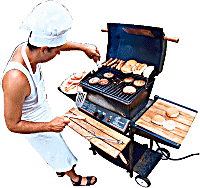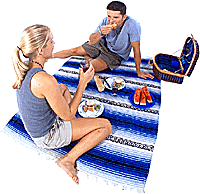 Don't let food poisoning Don't let food poisoning
spoil your summer outing!
Light up the
grill! Get out the picnic table! Summer has arrived! Many of us who live in
four-season climates look forward to outdoor activities during
the warmer time of year - cook-outs with friends and family,
community activities, and other outdoor events. But it's also
the time of year when many of us will be afflicted with food poisoning!
Over one million
cases of foodborne illness, or food poisoning, will develop this
year! Symptoms include nausea, vomiting, diarrhea, headache,
chills, and fever. Symptoms can begin within 12 to 24 hours after
eating the tainted food and can last anywhere from one day to
one week. Because a viral illness produces the same symptoms,
you may not realize you've been poisoned by something you ate.
How can you
tell if a food is contaminated? Unfortunately
you can't. Bacteria that cause foodborne illness can't be seen
and have no taste or smell. That's why it's so important to apply
preventive techniques and take precautions beforehand to keep
food safe.
The most common
types of bacteria that cause foodborne illness are Staphylococcus,
Clostridium, Salmonella, E-coli, and Listeria.
Staphylococcus, or Staph for short, is most commonly
found in custards, cream filled desserts, salads, meat, and starchy
foods like potato salad. Freezing food before serving to help
keep it cold is a good idea, but be aware that freezing foods
that contain Staph don't kill the toxins produced by the bacteria. Contrary to accepted belief,
mayonnaise, which contains vinegar, actually helps prevent bacterial
growth. Because vinegar has a low pH, it creates an acidic environment
that effectively retards the growth of Staph as well as other
kinds of bacteria. Contrary to accepted belief,
mayonnaise, which contains vinegar, actually helps prevent bacterial
growth. Because vinegar has a low pH, it creates an acidic environment
that effectively retards the growth of Staph as well as other
kinds of bacteria.
Clostridium
botulinum,
which cause
Botulism, live in an anaerobic environment, meaning little to
no oxygen, and can be found in canned foods. These bacteria produce
spores that are highly toxic. Symptoms include nervous system
dysfunction and death. Never use canned products that have been
dented at the seam.
Salmonella
and Listeria are found in raw meat,
poultry, cracked eggs, dairy products, and shellfish. Seafood
can contain Yersinia which cause Plague, V. cholerae which cause Cholera, and viruses that cause Hepatitis. E-coli are found in foods contaminated with feces such
as meat and seafood. Since E-coli live in the intestinal tract,
symptoms include diarrhea, dehydration, and death in severe cases.
Parasites and Protozoa are found in raw, uncooked foods. Once ingested,
they live in your intestinal tract, so symptoms may not show
up for weeks. Roundworms, found in pork and sausage,
cause Trichinosis, a painful disease. These microscopic worms,
called Trichinella, migrate to muscle tissue and the heart and
can cause death.
Molds live predominantly on
fruit, vegetables, cheese, and breads but do not produce toxins
that lead to food poisoning. Simply remove the part of the food
that's moldy, discard it, and the remainder of the food can be
eaten safely.
Red tide is caused by organisms that appear in
great numbers along the waters edge and are eaten by shellfish.
Cooking will not destroy these organisms. If ingested, symptoms
include facial numbness, paralysis, and difficulty breathing.
Some
tips to help prevent food poisoning:
- Cook thoroughly meat, pork, seafood,
poultry, eggs, and shellfish. Never eat these raw or partially
cooked.
- Never place
cooked
meat back on the same plate it was taken from when raw.
- Keep hot
foods hot and cold foods cold! Keep cold food at temperatures of 45
degrees or lower and hot food at 140 degrees or warmer.
- Store cold foods on ice in a styrofoam container.
Wrap hot
foods in aluminum foil and
store them in a separate container until they are ready to be
served.
- Never leave
food at room temperature for more than two hours.
- Never place
cold foods in the sun.
- Always use clean bags for storing leftovers.
Never use plastic bags or containers that have previously contained
food.
- Wash hands
thoroughly
with soap
and water after handling raw meat and before handling other foods.
- Warn your
children
about the dangers of eating wild mushrooms, berries, and other
kinds of
 plants. Never drink
stream or lake water unless boiled first. plants. Never drink
stream or lake water unless boiled first.
- When carrying
food in a picnic basket, eat it within two hours of placing the food in the basket. Include
frozen ice bags to help keep cold food cold. Store hot foods
in a thermos bottle.
NUtritionTipS
-On a hot day, drink liquids
that contain no sugar. Like salt, sugar causes dehydration.
-Food additives help make
food safe to eat by retarding the growth of microorganisms. Some
common additives are BHT, BHA, nitrites, MSG, salt, sugar, phosphates,
and vinegar.
-Barbequing meat over a grill
using charcoal causes the formation of benzene compounds which
are known cancer-causing substances.
-Freezer burn is found on
meat stored in the freezer that has not been wrapped well. It
appears white in color due to denaturing of the protein. Freezer
burn is not poisonous or toxic. Remove the portion of meat that's
burned, discard it, and use the remaining unaffected portion.
Where do you get your nutrition
information? Most states now have licensure laws for Dietitians
and Nutritionists. Be sure your nutrition advisor is "Licensed"
by the State as a Licensed Dietitian (LD) or Licensed Nutritionist
(LN), or in states that don't have licensure laws, a Registered
Dietitian.
CarboH,
Inc.
Barbara Herondorf, L.D.
Home |
FAQ's |
Sample Menu |
Policies
More About CarboH |
Order CarboH |
Contact Us |
Letters
|


